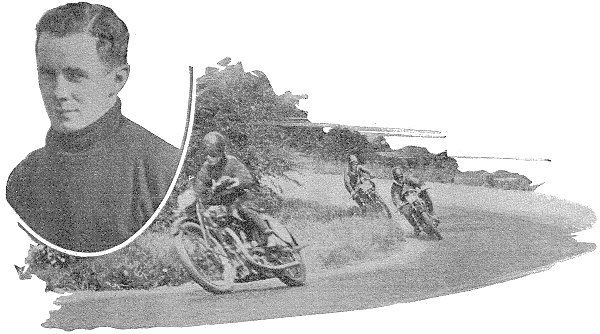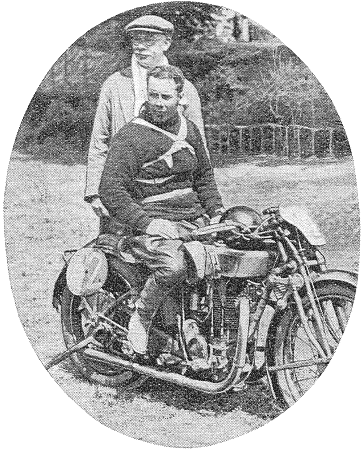|
An article from ‘The
Motor Cycle’ 8th November, 1928
A
Racing Rider Talks
An “Ace of the
Road” C. J. P. Dodson, on his nine years of speed work
in Britain and on the Continent.

Perhaps it would be advisable at
the beginning to point out, before it becomes too
obvious, the fact that I was never endowed with
journalistic talent, and I only hope the readers of the
"Blue 'Un" will appreciate this and make allowances
before reading farther.
And now, having made my apology,
let me get on with my subject. Perhaps it would be of
some interest if I related how I became interested in
the racing game. Back in 1920, when belt drive and
single gears were in fashion, I began to wonder what all
this racing business was about, and in consequence took
a trip over to Axe Edge to watch the boys perform, and
became, there and then, infected with the speed lure.
Early Efforts as an Amateur
Having decided that it was a real
he-man's game, I purchased my first racing machine, and
when I look back on its specification I smile, and yet
marvel at the strides made by the industry within the
last nine years. For four years I rode regularly at Axe
Edge and at Southport, and met with occasional successes
and not a few disappointments. After a time I became
more ambitious, and decided to enter the Amateur Road
Race of 1924.
To relate my experiences in this
race would require more space than 1 am allotted, but I
will say that race taught me a great deal, and the
experience gained was invaluable to me in the more
important races in which I competed. (I use the word
"important" purely from the point of view of a trade
rider, and do not wish in any way to detract from the
merits of the Amateur Road Race, which is, of course,
and rightly so, the most important race from an amateur
rider's point of view.
At the outset I realised that if I
had to cover 200 miles of the T.T. course at speed, it
would be necessary for me to be in perfect physical
condition. Therefore, I began to turn in early at
nights, get up early, in the morning, and do a 50 mile
ride before breakfast. I figured it in this way: in the
Island one has to be up for practice at 5 a.m., and
there is something strangely different in early morning
riding, which, if one is not used to it, is liable for a
time to restrict one's capabilities.
Even now, for two months prior to
the T.T. races, a motor cycle can be heard touring (I
dare not say blinding) through a certain section of
Derbyshire at 5 a.m., and no doubt many of you would lie
in bed and wonder who the poor mutt was! Nevertheless,
past events have proved to me that this preparation is
invaluable to a rider, if he wishes to figure well up in
the list of finishers when "Der Tag" arrives.
Man and Machine Must be Fit
Having, I hope, stressed the
necessity for perfect physical fitness, and preliminary
training, let us turn for a moment to the preparation of
the machine. When riding a factory bus there is of
course, very little a rider can do to it, beyond detail
work such as centre-popping all nuts, etc. But one thing
I consider most important - the adjustment of saddle;
footrests and handle-bars to suit one's individual
requirements.
Nothing can have such an adverse
effect on riding as a cramped position; only once have I
ever experienced any discomfort in this respect, but,
believe me, once was quite sufficient. How I finished
the race on that occasion I do not know, but of this I
am certain, that it is impossible to make the lightning
decisions necessary in a road race unless one can devote
all faculties to the job in hand. With an uncomfortable
machine that is impossible.

Two men win
races, the designer and the rider.
C. J. P. Dodson on his winning T.T. Sunbeam and
J. E. Greenwood, the designer of the machine. |
Having then disposed of (a) physical
fitness and training, and (b) preparation of
the machine, let us deal with temperament.
Only those who have experienced it, can
know what it is like sitting on the squares
on the morning of the race. It seems as if
the crowd on the stands are looking only at
you and smiling cynically at your chances.
You wonder whether you tightened up your
gear box nuts, put the right jet back after
that last morning's practice, whether that
plug oiled up when the engine last fired,
and a thousand things.
For myself, after the weighing in, I
prefer to forget all about the machine and
the T. T. until it is my turn to move up
into the starting square, when I turn on the
petrol, and offer up a prayer to the gods
that she will fire immediately at the word
"Go." For there is nothing more exhausting
physically nor disturbing to the nerves than
starting difficultly; a long and perhaps
fruitless push, the making of adjustments
when the fingers are "all thumbs," with
thousands of spectators looking on, may
easily destroy one's confidence for several
laps, if not far a whole race. |
One's first inclination is to turn
on all the taps and tear off down Bray Hill or wherever
the race may be. But after the first few hundred yards
or so, common sense asserts itself, and you turn back
your throttle just that little bit, which makes all the
difference between victory or defeat. I always adopt
this procedure, unless I am hard pressed, when obviously
I use all I have got, and trust to luck and a good
engine.
When “Expensive Noises" Arise
Sometimes you get through, and then
again sometimes you don't, that is the glorious
uncertainty of the game, but I am afraid when we hear an
"expensive noise," and have to retire, we are inclined
to view it from a different angle!
One point that always occurs to me
is the time some riders lose at the pits. Many times, as
a spectator, I have seen men lose seconds at the pits
that they have gained through sheer good riding on the
corners. The next time you are in the Island notice the
organisation at the pits of the old hands. The rider
comes in, opens his oil tank, fills it with oil, while
his assistant fills his petrol tanks. All is done calmly
and methodically, he is away again inside 20 seconds,
and he has still had time to snatch a drink, and a clean
pair of goggles. It is often at the pits that a race is
won or lost; and I cannot emphasise too strongly the
need for good organisation here.
This point is very much in evidence
in the Continental races in which our riders are so
often successful. It has been said that our boys are far
superior to our foreign rivals, but I am not in
agreement on this point. True, we do go over and figure
prominently in the final placings, but I feel sure if
some of the Continental riders were on machines of the
same calibre as our own, we should have to ride very,
very hard to beat them; not that it is easy as it is;
far from it. And I should like to say here, any English
rider who enters for any of the big Continental events,
is sure of a warm welcome, and every courtesy. I have
yet to find a finer body of sportsmen than those I have
had the pleasure of meeting on my various Continental
visits, and I am looking forward to renewing next season
the many acquaintances I have been fortunate enough to
make amongst the racing motorcyclists of other
countries.
Valuable Lessons from Racing
One often hears the opinion
expressed that road racing has no beneficial effect on
the standard production model; that the machines, are
specially built, and the races themselves only used as a
publicity medium for the manufacturers. Nothing is
farther from the truth! True, the machines are specially
built, and the successful entrants do advertise their
successes; why shouldn't they?
No doubt the average rider does not
require a machine capable of 90 m.p.h., but he does
require a strong, reliable engine and first-class
brakes, and I am fully convinced that the wonderful
value offered to the public today is the direct outcome
of racing experience. If our manufacturers are to
maintain this high standard of production, road racing
must continue. We cannot afford to let our foreign
competitors get ahead of us, even though they are, as we
know, making every effort. We have earned our pride of
place. Let us keep it.
 |